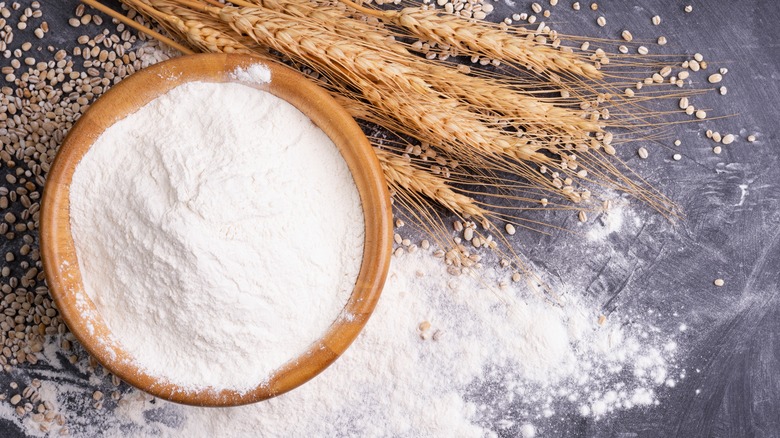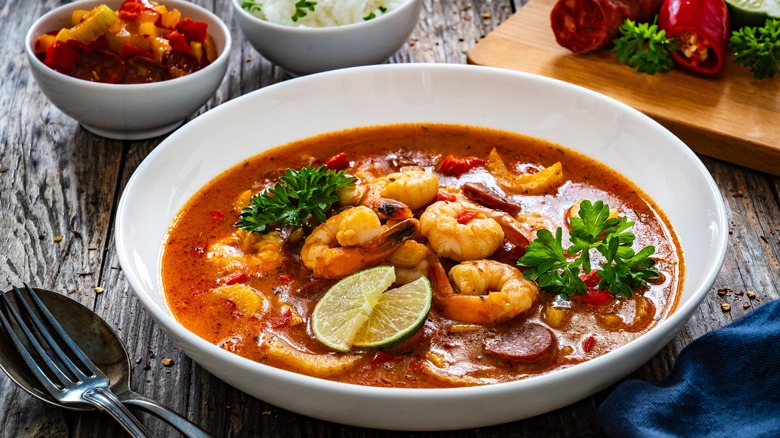A Roux Can Take Forever To Make, But Not With This Shortcut
Roux is foundational to so many dishes — gumbos, gravies, soups, and sauces. But despite its essential culinary nature, it's really quite simple. Roux is a mixture of equal parts flour and fat, typically butter or a neutral oil. You combine the two on the stovetop, stirring and cooking until it reaches your desired color along the roux color spectrum: light, blond, brown, and dark brown. Each of these roux types is used for a different purpose, because as the roux darkens, the flavor becomes more pronounced, richer, and nuttier. When it's added to a dish, roux thickens and binds the ingredients in addition to adding flavor.
However, it is laborious. Roux takes lots of hands-on time, requiring you to stir constantly so that it doesn't turn too dark or burn. Lighter roux will only take a few minutes, but it's crucial to add plenty of dark roux to gumbo, so if you're toasting a dark roux, you may be stuck at the stovetop for as much as an hour to get it right. It doesn't have to be that grueling, though — thanks to the dry roux. Dry roux is still a thickening agent with a toasty flavor, but it eliminates the fat and requires the use of an oven instead of time-consuming stovetop stirring.
Try a dry roux to save hands-on time
Dry roux can be made on the stove or even in the microwave, but using an oven lets you step away while still having control of the color. To make the dry roux, spread the flour in an oven-safe container — like a Pyrex casserole dish, a nonstick baking sheet, or a skillet that can withstand high heat — and put in the oven at about 400 degrees Fahrenheit. As the flour toasts, you'll need to stir it occasionally to make sure it cooks evenly, and once color starts to appear, keep an eye on it because the flour will darken quickly. When it's done, remove it from the cooking vessel to prevent it from continuing to toast.
The oven method will still take a while to reach the peanut butter color you'd want for the brown and dark brown roux. It may even take between an hour and an hour and a half, depending on how thinly you've spread the flour. However, you can go about your other culinary business while the toasting is done.
Roux gets its toasted flavor from the starch's undergoing the Maillard reaction, a chemical reaction that happens when proteins and sugars meet heat (the same thing that happens when you brown meat). Even in the oven, that reaction still happens, so dry roux doesn't lose the nutty taste. You just get the easier, oil-free version.
Once you make it, here's how to use it
The starch in roux is what helps it thicken dishes, but if you just tossed flour into your gumbo, you'd end up with clumps. Roux's paste form is part of what makes it so useful, since it incorporates easily — so when it comes to dry roux, you'll need to adjust slightly. Instead of throwing the dry roux into your dish by itself, whisk a little bit of room-temperature broth into it until you have a paste. This will help you avoid a clumpy mess.
Unlike traditional roux, dry roux can be made in batches. So you can toast some extra flour in the oven, then store it in an airtight container. It will keep for as much as six months, and you can have it on hand for using in delicious dishes like chicken and sausage gumbo or Creole sauce made with dark brown roux. You'll save yourself some energy but won't miss out on function or flavor.


